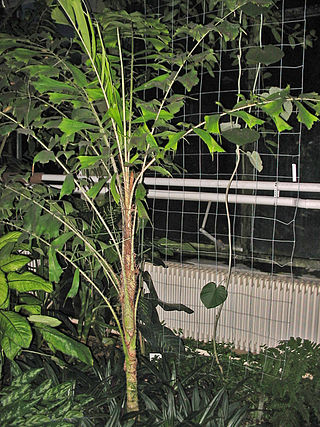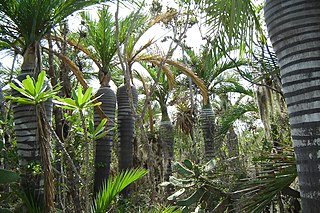
Aiphanes is a genus of spiny palms which is native to tropical regions of South and Central America and the Caribbean. There are about 26 species in the genus, ranging in size from understorey shrubs with subterranean stems to subcanopy trees as tall as 20 metres (66 ft). Most have pinnately compound leaves ; one species has entire leaves. Stems, leaves and sometimes even the fruit are covered with spines. Plants flower repeatedly over the course of their lifespan and have separate male and female flowers, although these are borne together on the same inflorescence. Although records of pollinators are limited, most species appear to be pollinated by insects. The fruit are eaten by several birds and mammals, including at least two species of amazon parrots.

Zombia antillarum, commonly known as the zombie palm, is a species of palm tree and the only member of the genus Zombia. It is endemic to the island of Hispaniola in the Greater Antilles. Usually found in dry, hilly areas of northern and southern Haiti and the northwest of the Dominican Republic, Z. antillarum is a relatively short fan palm with clustered stems and a very distinctive appearance caused by its persistent spiny leaf sheaths. Threatened by habitat destruction in Haiti, Z. antillarum is a popular ornamental species due to its distinctive appearance, low maintenance requirements and salt tolerance.

Pseudophoenix is a genus of palms which is native to the wider Caribbean. Three species of the four species are endemic to Hispaniola, while the fourth, P. sargentii, is widely distributed in the northern Caribbean, Florida, and the Yucatán Peninsula.

Pseudophoenix ekmanii is a palm species endemic to the Barahona Peninsula and Isla Beata in the Dominican Republic on the Caribbean island of Hispaniola.

Pseudophoenix vinifera is a palm species endemic to the Caribbean island of Hispaniola, in the Dominican Republic and Haiti.

Cryosophila is a genus of medium-sized fan palms that range from central Mexico to northern Colombia. Species in the genus can be readily distinguished from related genera by their distinctive downward-pointing spines on the stem, which are actually modified roots. They are known as the "root spine palms".

Itaya amicorum is a medium-size fan palm that is native to Brazil, Colombia and Peru. It is the only species in the genus Itaya. It was unknown to science until 1972, when it was discovered on the bank of the Itaya River in the Peruvian Amazon.

Phoenicophorium, the thief palm, is a monotypic genus of flowering plant in the family Arecaceae. The sole species is Phoenicophorium borsigianum.

Satakentia liukiuensis, is a species of palm tree. They are endemic to Ishigaki Island and Iriomote Island in the Yaeyama Islands, the south-westernmost of the Ryukyu Islands, Japan. It is the only species in the genus Satakentia.

Schippia concolor, the mountain pimento or silver pimeto, is a medium-sized palm species that is native to Belize and Guatemala. Named for its discoverer, Australian botanist William A. Schipp, the species is threatened by habitat loss. It is the sole species in the genus Schippia.

Cyclura cychlura inornata, the Allen Cays rock iguana or Allen Cays iguana, is a subspecies of the northern Bahamian rock iguana that is found on Allen's Cay and adjacent islands in the Bahamas. Its status in the IUCN Red List is critically endangered. The population has been growing over the last century. Although it was considered extinct in 1916, there are as of 2018 at least 482 mature adult animals counted on two islands, Leaf Cay and U Cay, and a few hundred on at least five other nearby islands where they have recently spread to by unknown means, as well as many juveniles.

Euterpe precatoria is a tall, slender-stemmed, pinnate-leaved palm native to Central and South America and Trinidad and Tobago. E. precatoria is used commercially to produce fruits, although Euterpe oleracea is more commonly cultivated due to its larger fruits.

Pseudophoenix sargentii, commonly known as the Florida cherry palm or buccaneer palm, is a medium-sized palm native to the northern Caribbean, eastern Mexico, and extreme southeast Florida in the United States.
Coccothrinax concolor is a palm which is endemic to Haiti.
Coccothrinax inaguensis, the thatch palm or Inagua silver palm, is a palm which is endemic to the Bahamas and the Turks and Caicos Islands.

Kerriodoxa elegans, the white backed palm, is the only species of palm tree in the genus Kerriodoxa, in the family Arecaceae.

Leucothrinax morrisii, the Key thatch palm, is a small palm which is native to the Greater Antilles, northern Lesser Antilles, The Bahamas and Florida and the Florida Keys in the United States.

Sabal causiarum, commonly known as the Puerto Rico palmetto or Puerto Rican hat palm, is a species of palm which is native to Hispaniola, Puerto Rico, and the British Virgin Islands. As its common and scientific names suggest, its leaves are used in the manufacture of "straw" hats.

Acrocomia is a genus of palms which is native to the Neotropics, ranging from Mexico in the north, through Central America and the Caribbean, and through South America south to Argentina.


















